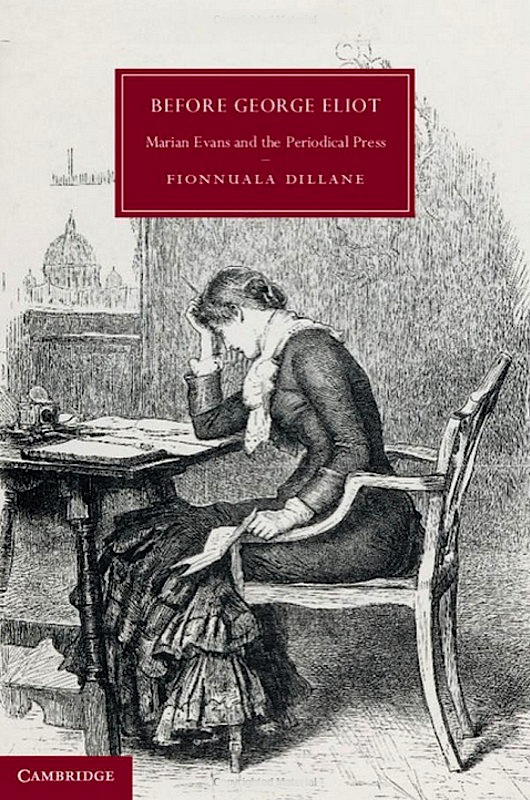This review is reproduced here by kind permission of the online inter-disciplinary journal Cercles, where it was first published. The original text has been adapted and reformatted for the Victorian Web, and illustrated by Jacqueline Banerjee. The illustrations, except the first one of the book cover, are from our own website. Click on the images for larger pictures, and more information.

Along with an introduction, conclusion, bibliography and index, this study of George Eliot's early career as a journalist comprises the following chapters: 1. "The Character of Editress: Marian Evans at the Westminster Review"; 2. "'Working for one's bread': Marian Evans the Journalist"; 3. "Staging 'Scenes' in Blackwood's Magazine: Melodrama, narrative voice and the Blackwood's man"; 4. "After Marian Evans: The importance of being 'George Eliot'"; and 5. "Last impressions: Marian Evans takes on her audience."
Numerous studies have been devoted to the iconic nineteenth-century writer George Eliot, but comparatively few to her as "Marian Evans," before she took on her male pseudonym. Yet "George Eliot'" the novelist was conceived only in the late 1850s. Hence Dillane's wish to focus on and revisit the first decade of Marian Evans's working life as a journalist, editor and serial fiction writer in the periodical press. This, as Dillane underscores, was of great importance in the construction of literary reputations, and more generally of culture in the nineteenth century. The nineteenth-century periodical being the dominant cultural force of the age, she sees it as no coincidence that the writer who became the leading literary figure of the second half of the nineteenth century began her writing career in the periodical press. Although she was never a very prolific journalist (her journalistic production only amounting to a total of eighty articles in her whole career), Marian Evans was always deeply concerned with the issues of her commercial, editorial and social environment.
However, the approach that Dillane supports here is quite original. Unlike the authors of earlier studies, she claims that Marian Evans's journalism is no simple rehearsal of George Eliot's key ideas in the widely acclaimed works still to come. Nor is it a literary manifesto of the concepts later developed in her fiction. Evans's work for the periodicals should therefore not be read for its contents only and retrospectively – that is, in the light of what comes afterwards, as a mere background and marginal occupation. On the contrary, Dillane demonstrates how Evans's journalistic career profoundly shaped the construction of her multifaceted literary persona and how the stylistic complexities of some of her journalistic voices inform the intricacy of her fictional narratives.


Left: George Eliot at 30. Right: Front cover of Blackwoods.
Indeed, one must not forget the manifold interdependence that exists between an article and the periodical in which it is published. Identification with the general spirit of the journal in which one is writing is a prerequisite of the task of the reviewer – and Evans knew exactly how to adapt to the various magazines she worked for (the liberal Westminster Review, the more conservative Saturday Review, the [radical] Leader). Nor is it possible to ignore Evans's developing sense of her audience in her different but related roles as a journalist, editor and serial fiction writer. Obviously, Evans knew how to meet the expectations of both her editor and her readers, as Dillane makes clear with the example of Scenes of Clerical Life, first published as a Blackwood's series. Dillane points out how the stories of Scenes of Clerical Life conform and adapt to the double purpose of the melodrama-prone periodical magazine, i.e. to divert and to edify – two characteristics of the original style of the Scenes.
The complicated question of the audience is certainly the cornerstone of this thorough study of Evans's early writing career, especially with the exposition of how Evans's practices as a journalist established the pattern for the complex and ambivalent relationship she entertained with her public throughout her writing life. Dillane's last two chapters address Evans's awareness of the British periodical as a model of audience-making, and her resentment of the periodical press and its readers. In the essays of Impressions of Theophrastus Such (1879), written at the end of her life under the name of George Eliot, she repeatedly attacked this press for its omnipotence and its lack of respect for writers in particular and culture in general. It is therefore ironic that the very medium that helped her shape her literary persona should have been the target of her wrath when she became a renowned novelist, yet her attitude reveals the major role she ascribed to the media in the construction of literary fame.
While "George Eliot" only has a public persona, Marian Evans remains very much behind the scenes. Yet the author George Eliot has no flesh: she is just an impersonation, a disembodied fiction. This study claims to give flesh to Marian Evans before she became George Eliot. By unearthing and rehabilitating the early writings that so much influenced the writer's legacy, it invites us to reconsider our conception of the novelist.
Related Material
- The Great Wen: Reviews of Rosemary Ashton’s 142 Strand: A Radical Address in Victorian London and Lee Jackson’s A Dictionary of Victorian London
- The "Blackwood's Tale": An Enduring Legacy
- Scenes of Clerical Life
Book under Review
Dillane, Fionnuala. Before George Eliot: Marian Evans and the Periodical Press. Cambridge: University Press, 2013. ix + 270 pp. Hardcover. ISBN 978-1107035652. £60.00.
Created 21 March 2015